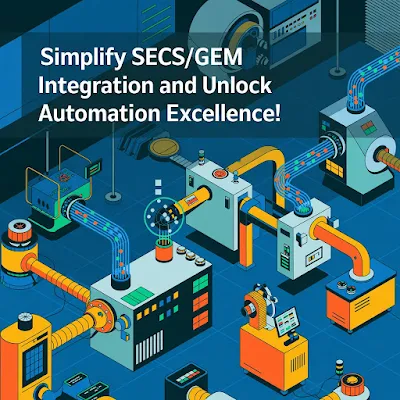The semiconductor industry, known for its rapid evolution, is embracing transformative technologies like Artificial Intelligence (AI) and Machine Learning (ML). These innovations are revolutionizing design, manufacturing, and testing processes, helping semiconductor manufacturers achieve greater efficiency and accuracy. A key enabler in this ecosystem is the SECS/GEM protocol, a standardized communication protocol used to facilitate automation and data exchange between factory host systems and manufacturing equipment. By leveraging AI/ML alongside SECS/GEM integration, semiconductor companies can unlock unprecedented levels of operational excellence.
Introduction to SECS/GEM and AI/ML in Semiconductors
The SECS GEM protocol (SEMI Equipment Communication Standard/Generic Equipment Model) is integral to modern semiconductor manufacturing. It enables seamless communication between host systems and equipment, allowing for real-time monitoring, control, and data collection. In parallel, AI/ML technologies are driving smarter automation, predictive maintenance, and enhanced decision-making.
Combining AI/ML with SECS/GEM communication protocols offers manufacturers a significant edge. From improving equipment uptime to reducing production errors, the synergy between these technologies is redefining the semiconductor landscape. Let’s explore how AI/ML is enhancing semiconductor processes and the role of SECS/GEM integration in facilitating these advancements.
The Role of AI/ML in Semiconductor Manufacturing
1. Enhanced Process Automation
AI/ML technologies excel at analyzing complex datasets to identify patterns and optimize processes. When integrated with SECS GEM software, these tools enable dynamic adjustments to manufacturing workflows, ensuring optimal production rates and reduced errors.
For instance, predictive algorithms can monitor equipment behavior and trigger real-time adjustments via the SECS/GEM interface. This level of automation minimizes downtime and maximizes yield, making AI/ML a critical component in modern fabs.
2. Predictive Maintenance
Machine learning models can analyze historical data to predict when equipment is likely to fail or require maintenance. Using SECS GEM communication protocols, manufacturers can integrate these predictive insights with their factory systems to schedule timely interventions.
This proactive approach not only extends equipment life but also reduces unexpected disruptions. By combining AI-driven insights with SECS/GEM integration, manufacturers can ensure a seamless production flow.
3. Quality Control and Defect Detection
AI-powered vision systems and ML algorithms are enhancing defect detection in semiconductor manufacturing. These systems analyze wafers and components at the microscopic level, identifying anomalies that may impact performance.
Using the SECS GEM protocol, this data can be communicated instantly to factory systems, allowing for immediate corrective actions. This ensures that manufacturers maintain high-quality standards while reducing waste.
SECS/GEM: The Backbone of Semiconductor Automation
The SECS GEM communication protocol is the foundation of semiconductor automation. It standardizes interactions between equipment and host systems, enabling:
Real-time Monitoring: With SECS/GEM communication, manufacturers can track equipment performance and production metrics in real time.
Data Integration: SECS/GEM interfaces facilitate seamless data exchange between various tools and systems.
Scalability: As manufacturing facilities expand, SECS/GEM integration ensures that new equipment integrates seamlessly with existing systems.
For small and medium manufacturers, adopting SECS/GEM software can level the playing field by providing access to the same advanced automation capabilities used by industry giants.
AI/ML and SECS/GEM Integration: A Powerful Combination
Driving GEM300 Compliance
The semiconductor industry relies on standards like GEM300 for 300mm wafer manufacturing. AI/ML tools, integrated with SECS GEM communication protocols, simplify compliance with these standards. For instance, AI can optimize material handling systems, while SECS/GEM interfaces ensure proper communication between tools and host systems.
Improving Decision-Making
The combination of AI/ML and SECS/GEM enables manufacturers to collect and analyze vast amounts of data. This drives smarter decision-making, from optimizing production schedules to enhancing supply chain efficiency.
Enabling Smart Factories
AI/ML technologies, when paired with SECS/GEM integration, form the backbone of smart factories. These factories leverage data-driven insights and automation to deliver higher yields, lower costs, and better product quality.
The future of semiconductor manufacturing lies at the intersection of AI/ML and SECS/GEM integration. Together, these technologies are enabling manufacturers to automate complex processes, enhance quality, and achieve greater operational efficiency. From predictive maintenance to smart defect detection, the synergy between AI/ML innovations and SECS GEM communication protocols is driving the industry forward.
For manufacturers looking to stay competitive in this fast-paced industry, adopting SECS/GEM software and leveraging AI/ML technologies is not just an option—it’s a necessity. By embracing these advancements, companies can position themselves as leaders in the era of smart manufacturing.


